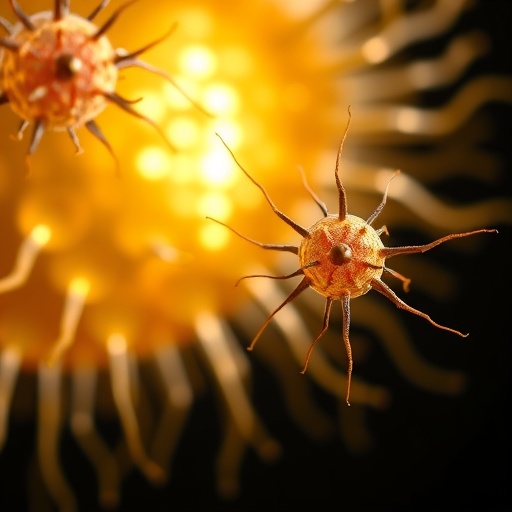In an unprecedented breakthrough, researchers from KTH Royal Institute of Technology and Stanford University have unveiled a detailed spatial proteomic map of primary cilia in human cells, shining new light on the intricate cellular antennae that play critical roles in sensing and interpreting extracellular signals. This landmark study, published in the prestigious journal Cell, represents a significant leap forward in our understanding of ciliary biology, a field that holds promise for unraveling complex disease mechanisms and advancing therapeutic strategies.
Primary cilia, the slender, antenna-like structures that extend from nearly every cell in the human body, have long been recognized as pivotal sensory organelles. Unlike their motile counterparts, which facilitate fluid flow and movement, primary cilia operate as hubs for cellular communication, detecting mechanical and chemical stimuli integral to cellular function and development. Until now, the comprehensive protein architecture of these organelles remained largely elusive, limiting progress in linking ciliary dysfunction to a spectrum of rare genetic disorders known as ciliopathies.
Leveraging next-generation imaging technologies alongside sophisticated antibody-based detection methods, the research team meticulously analyzed over 128,000 individual cilia across three distinct human cell types. This exhaustive spatial proteomics approach identified an astonishing 715 proteins localized within various subdomains of the primary cilium, each presumably tailored to mediate specific sensing tasks such as detecting hormones or mechanical forces. Such granular insight into protein distribution within the cilium underscores the organelle’s remarkable adaptability to the functional demands of its host cell.
Among the novel findings, the identification of 91 previously uncharacterized ciliary proteins stands out as a transformative contribution. These proteins expand the repertoire of molecular players implicated in ciliary function and hint at undiscovered mechanisms by which cells fine-tune signal transduction. The heterogeneity of protein composition observed across the primary cilia demonstrates that these organelles are not monolithic entities but rather dynamic, context-dependent processors of vital biological information.
Professor Emma Lundberg, the lead investigator of the study based at KTH, emphasized the clinical implications of these discoveries. By integrating their proteomic data with genetic information from patients with undiagnosed syndromic conditions, the researchers pinpointed a variant in the gene CREB3, linking it to ciliopathy-like symptoms in a pediatric patient. This correlation advances our understanding of ciliopathies, diseases characterized by defective ciliary proteins that manifest in multifaceted clinical syndromes affecting the brain, kidneys, skeleton, and sensory organs.
The intricate association between ciliary protein composition and cellular specialization suggests that primary cilia dynamically adjust their proteomes to meet distinct physiological requirements. This functional specialization likely underpins the diverse manifestations of ciliopathies, which range from polydactyly and intellectual disabilities to blindness and renal anomalies. By elucidating the spatial heterogeneity of these proteins, the study opens new avenues for precise molecular diagnostics and targeted therapeutics tailored to ciliary dysfunction.
Jan Hansen, the study’s first author affiliated with Stanford University, highlighted the transformative potential of constructing a comprehensive atlas of ciliary proteins. This resource offers unprecedented resolution in mapping the spatial and functional landscape of cilia, addressing longstanding challenges in diagnosing and understanding rare disorders rooted in ciliary anomalies. The heterogeneity revealed at the proteomic level provides a framework for dissecting how mutations in distinct ciliary components translate into the spectrum of patient phenotypes observed clinically.
A notable aspect of the research is its commitment to open science. The entire dataset has been made publicly accessible through the Human Protein Atlas, a global resource facilitating knowledge exchange among scientists and clinicians. This transparency fosters collaborative efforts aimed at deciphering ciliary biology and its pathological deviations, accelerating the translation of fundamental insights into clinical innovations.
The study’s methodology is a testament to the power of integrating cutting-edge imaging modalities with proteomic profiling. Advanced antibody-based mapping techniques allowed for the spatial localization of proteins within the confines of the tiny ciliary structure, overcoming technical barriers that historically hindered detailed analyses of such minute organelles. The combination of high-throughput data collection with rigorous bioinformatics enabled the identification of protein networks operative within different ciliary compartments.
Furthermore, the collaborative nature of the research, involving institutions across Sweden and the United States—including the Science for Life Laboratory in Sweden and the Chan Zuckerberg Imaging Institute—highlights the interdisciplinary effort essential for tackling complex biological questions. This synergy has yielded a refined portrait of primary cilia, transforming them from enigmatic cellular appendages into well-characterized, multifunctional sensor hubs.
This breakthrough holds significant promise for improving clinical care. Enhanced understanding of ciliary composition and dysfunction can lead to the development of novel biomarkers for early diagnosis of ciliopathies, many of which currently defy straightforward genetic identification due to their heterogeneity. In addition to diagnostic relevance, these insights may inform the design of targeted therapies that restore or compensate for defective ciliary functions, offering hope to patients afflicted by these complex disorders.
The revelation that primary cilia possess intrinsic heterogeneity tailored to cellular context overturns previous notions of their uniformity and emphasizes the importance of considering cellular identity in ciliary studies. By teasing apart the specialized proteomic landscapes of cilia in various cell types, this research paves the way for more nuanced therapeutic approaches that respect the organelle’s biological diversity.
In sum, this pioneering spatial proteomics study delineates a comprehensive protein atlas of primary cilia, unveiling their sophisticated molecular framework and implicating novel disease genes. Its contributions resonate across the realms of basic biology, clinical genetics, and therapeutic development, marking a turning point in how scientists understand and potentially treat ciliopathies. The data’s availability through the Human Protein Atlas ensures that the scientific community can build upon this foundation, fostering ongoing discoveries in the captivating world of ciliary biology.
Subject of Research: Primary cilia proteomics and their role in human disease
Article Title: Intrinsic Heterogeneity of Primary Cilia Revealed Through Spatial Proteomics
News Publication Date: 26-Sep-2025
Web References:
https://doi.org/10.1016/j.cell.2025.08.039
https://www.proteinatlas.org/
References:
Hansen, J., Lundberg, E., et al. Intrinsic Heterogeneity of Primary Cilia Revealed Through Spatial Proteomics. Cell. 2025.
Image Credits: KTH Royal Institute of Technology
Keywords: Primary cilia, spatial proteomics, ciliopathies, cellular signaling, protein mapping, CREB3, imaging analysis, rare disorders, cellular antenna, Human Protein Atlas




